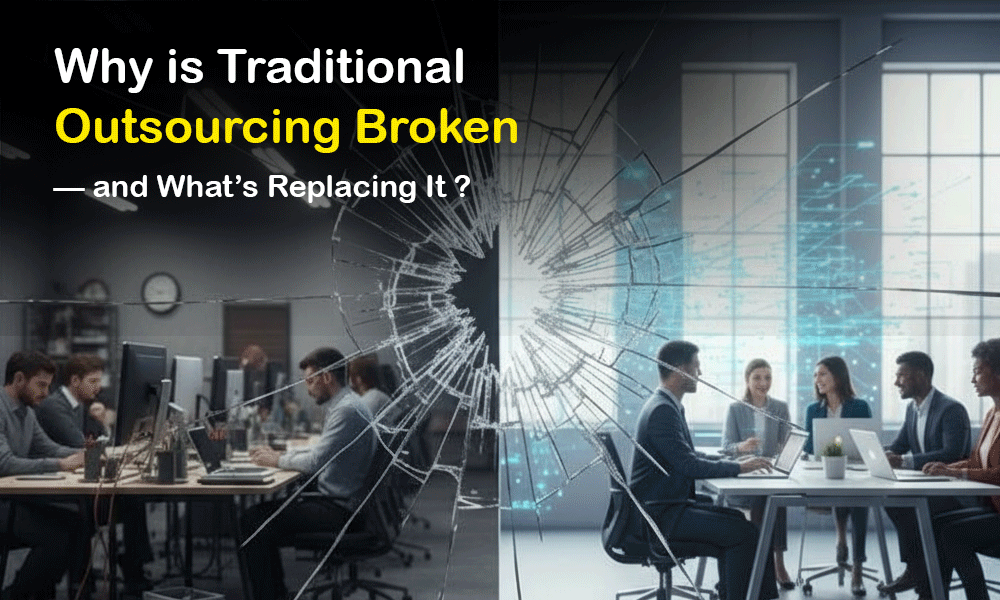For years, outsourcing was the go-to strategy for cutting costs. It promised efficiency, global reach, and flexibility. But today, mid-size businesses are realizing that outsourcing is less a solution and more a liability. Hidden costs creep in, innovation stalls, and vendor dependency grows. The cracks are too big to ignore.
Enter the global capability center- unlike outsourcing, a GCC (global capability center) isn’t about renting talent—it is about building ownership. Companies in the US, from agriculture to technology, are rethinking their global strategy. And increasingly, they’re choosing GCCs in India as the smarter, future-proof path forward.
The Breaking Point: Outsourcing’s Fading Value
The signs of outsourcing’s decline are everywhere. Recent global capability center-related news has highlighted how major companies are scaling back their vendor partnerships because service quality has suffered. Delivery delays, compliance failures, and customer dissatisfaction have all been tied to overreliance on outsourcing.
Even outsourcing’s biggest selling point — cost — has lost credibility. Studies show that businesses spend more on hidden charges and vendor markups than they ever expected. In fact, global capability center companies report that clients are shifting to in-house models because vendor-driven inefficiencies outweigh the initial savings in the typical outsourcing model.
This is why outsourcing feels outdated. The market is telling us that the model no longer delivers on its promises. Meanwhile, the GCC model is stepping up as a modern replacement, creating accountability, efficiency, and a pathway to real value.
Expert Takes: Traditional Outsourcing vs. Modern Alternatives
Industry experts agree outsourcing is running out of steam. Analysts tracking global capability center challenges note that businesses need more control, transparency, and cultural alignment than outsourcing can offer. When operations are hidden inside vendor contracts, innovation stalls and accountability weakens.
Research done by Indian global capability center consulting firms shows a clear trend, especially when C-Suite and C-1 level leaders were surveyed. Companies want offshore teams that act as partners, not vendors. Experts point out that outsourcing has failed to evolve with modern needs like AI adoption, data security, and compliance. In contrast, GCCs give leaders direct ownership of teams and processes, without vendor interference.
This shift is happening across industries — tech, finance, airlines, healthcare — as firms realize they can’t depend on outsourcing anymore. Global capability center operating models are proving to be not just an alternative, but the future.
How HQ Alignment Unlocks 3x GCC Value Creation
The biggest strength of a global capability center in India is how closely it aligns with its headquarters in a country like, say, the USA. Instead of being “off to the side,” a GCC becomes an extension of the parent company’s operations.
Through a global capability center advisory firm, mid-size businesses can design governance models that ensure offshore teams follow HQ’s culture, standards, and goals. Studies show that headquarter-aligned GCCs generate up to 3x more productivity than outsourced vendors.
Unlike outsourcing, a global capability center in India doesn’t just execute tasks. It creates value, nurtures innovation, and keeps every dollar tied to your strategy.
The India Advantage: World’s GCC Powerhouse

Why India? Because it’s the world’s most proven hub for GCCs. With a rich talent pool, strong STEM education, and decades of offshoring expertise, India is uniquely positioned to host global teams.
The global capability center operating model thrives here because businesses find cost efficiency without sacrificing skill. India offers engineers, analysts, and managers who can scale complex operations smoothly.
That’s why more companies are going for a GCC in India. It’s not just about saving money; it’s about plugging into a system that delivers global talent, local efficiency, and cultural adaptability — all in one place.
From Captive Centers to Centers of Excellence
Early GCCs were called “captive centers,” built only to handle repetitive, back-office tasks. That era is gone. Today, firms are turning their offshore units into Centers of Excellence (CoEs).
As part of the GCC architecture, businesses are building offshore hubs that focus on R&D, product development, and advanced analytics. These aren’t cost-saving shells; they’re innovation engines. Advisory partners are helping businesses transform their GCCs into CoEs, guiding everything from talent strategy to performance measurement. This shift marks the true break from outsourcing’s limitations.
Outsourcing Can’t Keep Up With AI-Led Global Capability Center Operating Model
The rise of AI and Gen AI has exposed outsourcing’s major weaknesses—AI preparedness. Vendors aren’t incentivized to invest in cutting-edge tech for clients. Instead, they stick to billing hours and maintaining margins.
That’s where GCCs shine. With direct ownership, firms can embed AI-driven processes into daily workflows. Global capability center companies in India allow you to experiment with new tools, integrate automation, and scale innovation. Every challenge around AI adoption is solvable because you control the investment and training. With outsourcing, the vendor holds you back. With GCCs, you set the pace.
Real Industries, Real Impact: Semiconductors, Airlines, and Tech
Industries like semiconductors, airlines, and tech are already proving the GCC model’s strength.
Semiconductor leaders run their own global capability centers in India to manage supply chains and R&D. Airlines use GCCs to centralize operations, from ticketing platforms to predictive maintenance analytics. And in tech, GCCs are where product engineering and AI innovation thrive.
These industries highlight a simple truth: outsourcing can’t match the strategic impact of GCCs. It’s not just about efficiency — it’s about building offshore teams that innovate, scale, and strengthen your core business.
Outsourcing Had Its Moment, But That Moment Has Passed
Rising costs, lack of innovation, and vendor dependency have exposed the flaws of outsourcing, rendering it unreliable and outdated as a model for mid-size businesses.
With proper planning and execution, firms take control and ownership of their offshore GCC-type execution and transition.
The future belongs to companies that stop outsourcing and start building with GCCs that deliver innovation and resilience along with cost savings.



